Compare these gun death rates: The U.S. is in a different world

The mass shooting Sunday in Orlando, Florida, was appalling in scale: 49 killed in a single attack. But it’s not unusual for dozens of Americans to be killed by guns in a single day.
Gun homicides are a common cause of death in the United States, killing about as many people as car crashes (not counting van, truck, motorcycle or bus accidents). Some cases command our attention more than others, of course. Counting mass shootings that make headlines and the thousands of Americans murdered one or a few at a time, gunshot homicides totaled 11,961 in 2014, according to the FBI.
This level of violence makes the United States an extreme outlier when measured against the experience of other advanced countries.
Around the world, those countries have substantially lower rates of deaths from gun homicide. In Germany, being murdered with a gun is as uncommon as being killed by a falling object in the United States. About two people out of every million are killed in a gun homicide. Gun homicides are just as rare in several other European countries, including the Netherlands and Austria. In the United States, two per million is roughly the death rate for hypothermia or plane crashes.
In Poland and England, only about one out of every million people die in gun homicides each year — about as often as an American dies in an agricultural accident or falling from a ladder. In Japan, where gun homicides are even rarer, the likelihood of dying this way is about the same as an American’s chance of being killed by lightning — roughly one in 10 million.
In the United States, the death rate from gun homicides is about 31 per million people — the equivalent of 27 people shot dead every day of the year. The homicides include losses from mass shootings, like Sunday’s Orlando attack, or the San Bernardino, California, shooting in December. And of course, they also include the country’s vastly more common single-victim killings.
To give you a sense of how unusual America’s gun violence problem is, consider the daily death toll compared with other Western democracies.
International comparisons help highlight how exceptional the United States is. In a nation where the right to bear arms is cherished by much of the population, gun homicides are a significant public health concern. For men 15-29, they are the third-leading cause of death, after accidents and suicides. In other high-income countries, gun homicides are unusual events. Last year’s Paris attacks killed 130 people, which is nearly as many as die from gun homicides in all of France in a typical year. But even if France had a mass shooting as deadly as the Paris attacks every month, its annual rate of gun homicide deaths would be lower than that in the United States.
Our gun homicide numbers come from the Small Arms Survey, a Swiss nonprofit affiliated with the Graduate Institute of International and Development Studies, and represent the average gun homicide death rates in those countries between 2007 and 2012. The U.S. death rates come from the Centers for Disease Control and Prevention over those same years. There are more recent statistics on U.S. gun deaths, like the FBI number at the top of this article, but we chose these years to provide fair comparisons. We focused on the rates of gun homicides; the overall rate of gun deaths is substantially higher, because suicides make up a majority of gun deaths in the United States and are also higher than in other developed countries.
The rate of gun violence in the United States is not the highest in the world. In parts of Central America, Africa and the Middle East, the gun death rates are even higher — close to those from heart attacks and lung cancer in the United States. In neighboring Mexico, where a drug war rages, 122 people per million die in a gun homicide, a rate slightly higher than Americans’ death rate from pancreatic cancer. But the countries with those levels of gun violence are not like the United States in many other ways, including GDP, life expectancy and education. Among developed democracies, the United States is an outlier.
Categories: -News-
02
Key facts about Americans and guns
 A customer shops for a handgun at a gun store in Florida. (Joe Raedle/Getty Images)
A customer shops for a handgun at a gun store in Florida. (Joe Raedle/Getty Images)
Guns are deeply ingrained in American society and the nation’s political debates.
The Second Amendment to the United States Constitution guarantees the right to bear arms, and about a third of U.S. adults say they personally own a gun. At the same time, in response to concerns such as rising gun death rates and mass shootings, President Joe Biden has proposed gun policy legislation that would expand on the bipartisan gun safety bill Congress passed last year.
Here are some key findings about Americans’ views of gun ownership, gun policy and other subjects, drawn primarily from a Pew Research Center survey conducted in June 2023.
Pew Research Center conducted this analysis to summarize key facts about Americans and guns. We used data from recent Center surveys to provide insights into Americans’ views on gun policy and how those views have changed over time, as well as to examine the proportion of adults who own guns and their reasons for doing so.
The analysis draws primarily from a survey of 5,115 U.S. adults conducted from June 5 to June 11, 2023. Everyone who took part in the surveys cited is a member of the Center’s American Trends Panel (ATP), an online survey panel that is recruited through national, random sampling of residential addresses. This way nearly all U.S. adults have a chance of selection. The survey is weighted to be representative of the U.S. adult population by gender, race, ethnicity, partisan affiliation, education and other categories. Read more about the ATP’s methodology.
Here are the questions used for the analysis on gun ownership, the questions used for the analysis on gun policy, and the survey’s methodology.
Additional information about the fall 2022 survey of parents and its methodology can be found at the link in the text of this post.
Measuring gun ownership in the United States comes with unique challenges. Unlike many demographic measures, there is not a definitive data source from the government or elsewhere on how many American adults own guns.
The Pew Research Center survey conducted June 5-11, 2023, on the Center’s American Trends Panel, asks about gun ownership using two separate questions to measure personal and household ownership. About a third of adults (32%) say they own a gun, while another 10% say they do not personally own a gun but someone else in their household does. These shares have changed little from surveys conducted in 2021 and 2017. In each of those surveys, 30% reported they owned a gun.
These numbers are largely consistent with rates of gun ownership reported by Gallup, but somewhat higher than those reported by NORC’s General Social Survey. Those surveys also find only modest changes in recent years.
The FBI maintains data on background checks on individuals attempting to purchase firearms in the United States. The FBI reported a surge in background checks in 2020 and 2021, during the coronavirus pandemic. The number of federal background checks declined in 2022 and through the first half of this year, according to FBI statistics.
About four-in-ten U.S. adults say they live in a household with a gun, including 32% who say they personally own one, according to an August report based on our June survey. These numbers are virtually unchanged since the last time we asked this question in 2021.
There are differences in gun ownership rates by political affiliation, gender, community type and other factors.Republicans and Republican-leaning independents are more than twice as likely as Democrats and Democratic leaners to say they personally own a gun (45% vs. 20%).40% of men say they own a gun, compared with 25% of women.47% of adults living in rural areas report personally owning a firearm, as do smaller shares of those who live in suburbs (30%) or urban areas (20%).38% of White Americans own a gun, compared with smaller shares of Black (24%), Hispanic (20%) and Asian (10%) Americans.
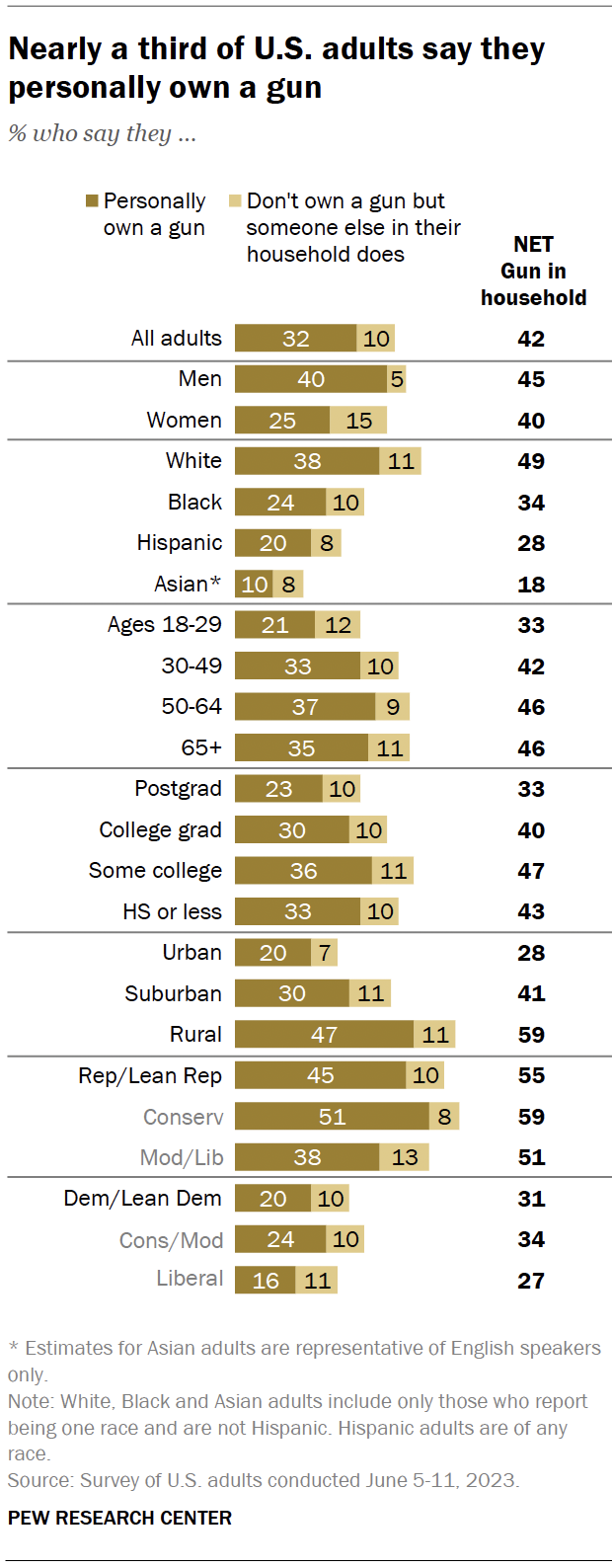
Personal protection tops the list of reasons gun owners give for owning a firearm. About three-quarters (72%) of gun owners say that protection is a major reason they own a gun. Considerably smaller shares say that a major reason they own a gun is for hunting (32%), for sport shooting (30%), as part of a gun collection (15%) or for their job (7%).
The reasons behind gun ownership have changed only modestly since our 2017 survey of attitudes toward gun ownership and gun policies. At that time, 67% of gun owners cited protection as a major reason they owned a firearm.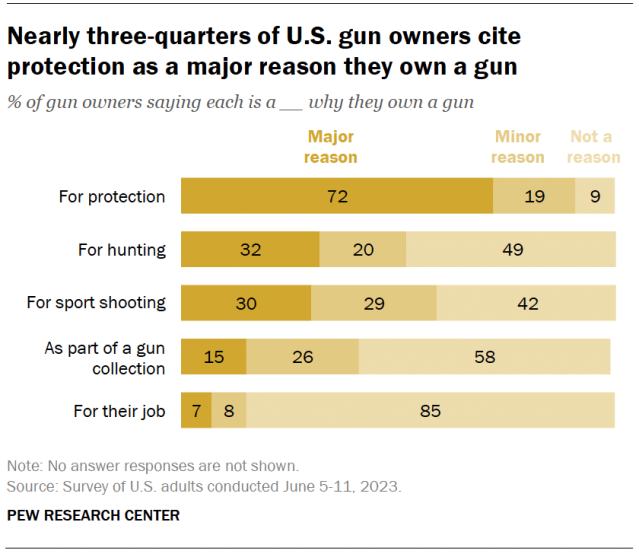
Gun owners tend to have much more positive feelings about having a gun in the house than non-owners who live with them. For instance, 71% of gun owners say they enjoy owning a gun – but far fewer non-gun owners in gun-owning households (31%) say they enjoy having one in the home. And while 81% of gun owners say owning a gun makes them feel safer, a narrower majority (57%) of non-owners in gun households say the same about having a firearm at home. Non-owners are also more likely than owners to worry about having a gun in the home (27% vs. 12%, respectively).
Feelings about gun ownership also differ by political affiliation, even among those who personally own firearms. Republican gun owners are more likely than Democratic owners to say owning a gun gives them feelings of safety and enjoyment, while Democratic owners are more likely to say they worry about having a gun in the home.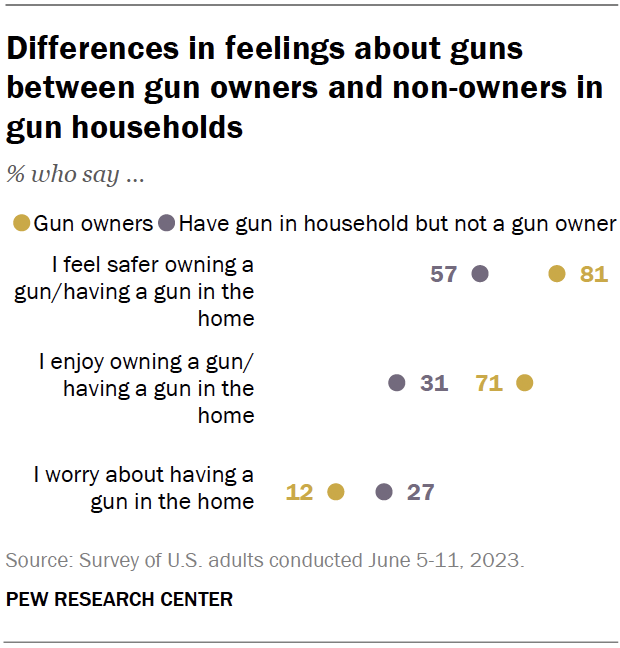
Non-gun owners are split on whether they see themselves owning a firearm in the future. About half (52%) of Americans who don’t own a gun say they could never see themselves owning one, while nearly as many (47%) could imagine themselves as gun owners in the future.
Among those who currently do not own a gun:
Americans are evenly split over whether gun ownership does more to increase or decrease safety. About half (49%) say it does more to increase safety by allowing law-abiding citizens to protect themselves, but an equal share say gun ownership does more to reduce safety by giving too many people access to firearms and increasing misuse.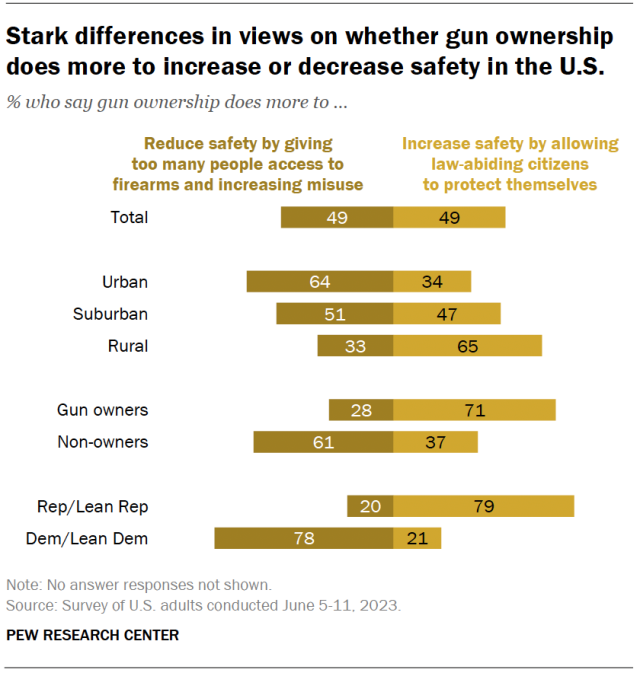
Republicans and Democrats differ on this question: 79% of Republicans say that gun ownership does more to increase safety, while a nearly identical share of Democrats (78%) say that it does more to reduce safety.
Urban and rural Americans also have starkly different views. Among adults who live in urban areas, 64% say gun ownership reduces safety, while 34% say it does more to increase safety. Among those who live in rural areas, 65% say gun ownership increases safety, compared with 33% who say it does more to reduce safety. Those living in the suburbs are about evenly split.
Americans increasingly say that gun violence is a major problem. Six-in-ten U.S. adults say gun violence is a very big problem in the country today, up 9 percentage points from spring 2022. In the survey conducted this June, 23% say gun violence is a moderately big problem, and about two-in-ten say it is either a small problem (13%) or not a problem at all (4%).
Looking ahead, 62% of Americans say they expect the level of gun violence to increase over the next five years. This is double the share who expect it to stay the same (31%). Just 7% expect the level of gun violence to decrease.
A majority of Americans (61%) say it is too easy to legally obtain a gun in this country. Another 30% say the ease of legally obtaining a gun is about right, and 9% say it is too hard to get a gun. Non-gun owners are nearly twice as likely as gun owners to say it is too easy to legally obtain a gun (73% vs. 38%). Meanwhile, gun owners are more than twice as likely as non-owners to say the ease of obtaining a gun is about right (48% vs. 20%).
Partisan and demographic differences also exist on this question. While 86% of Democrats say it is too easy to obtain a gun legally, 34% of Republicans say the same. Most urban (72%) and suburban (63%) dwellers say it’s too easy to legally obtain a gun. Rural residents are more divided: 47% say it is too easy, 41% say it is about right and 11% say it is too hard.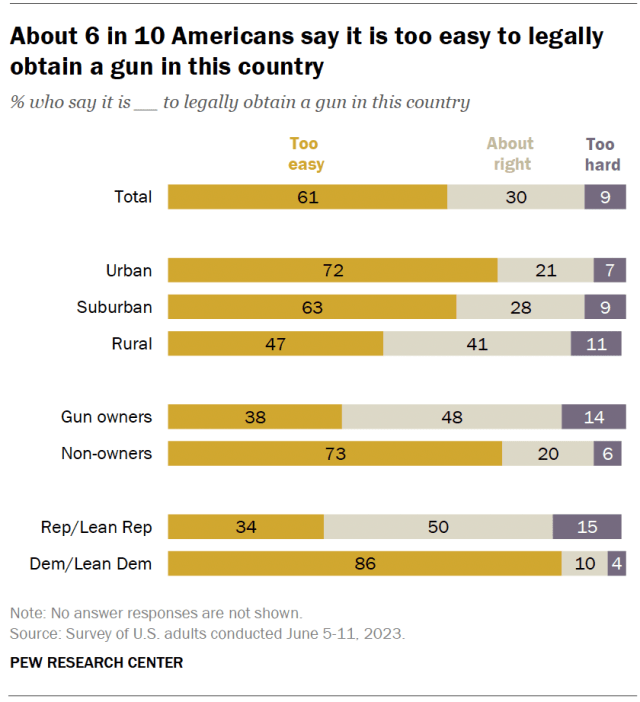
About six-in-ten U.S. adults (58%) favor stricter gun laws. Another 26% say that U.S. gun laws are about right, and 15% favor less strict gun laws. The percentage who say these laws should be stricter has fluctuated a bit in recent years. In 2021, 53% favored stricter gun laws, and in 2019, 60% said laws should be stricter.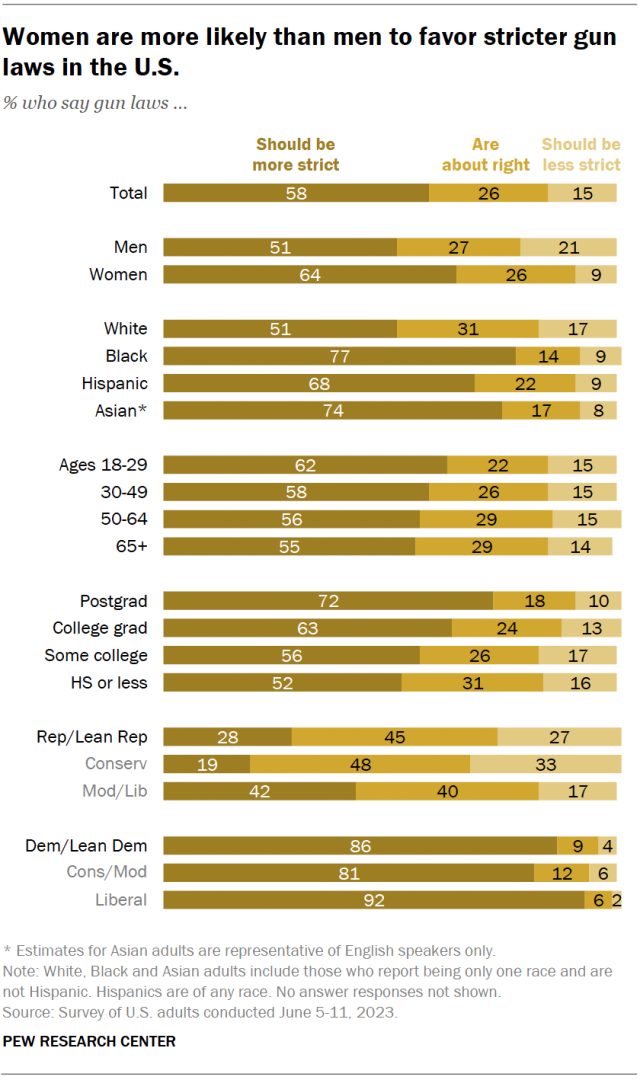
About a third (32%) of parents with K-12 students say they are very or extremely worried about a shooting ever happening at their children’s school, according to a fall 2022 Center survey of parents with at least one child younger than 18. A similar share of K-12 parents (31%) say they are not too or not at all worried about a shooting ever happening at their children’s school, while 37% of parents say they are somewhat worried.
Among all parents with children under 18, including those who are not in school, 63% see improving mental health screening and treatment as a very or extremely effective way to prevent school shootings. This is larger than the shares who say the same about having police officers or armed security in schools (49%), banning assault-style weapons (45%), or having metal detectors in schools (41%). Just 24% of parents say allowing teachers and school administrators to carry guns in school would be a very or extremely effective approach, while half say this would be not too or not at all effective.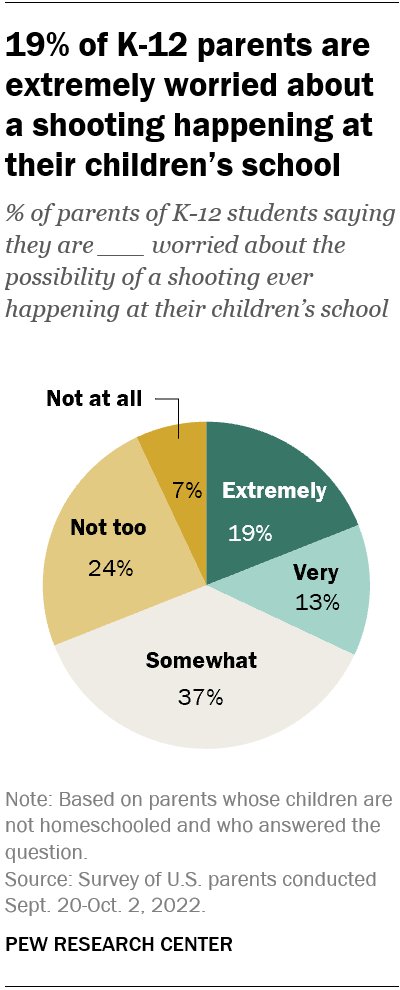
There is broad partisan agreement on some gun policy proposals, but most are politically divisive, the June 2023 survey found. Majorities of U.S. adults in both partisan coalitions somewhat or strongly favor two policies that would restrict gun access: preventing those with mental illnesses from purchasing guns (88% of Republicans and 89% of Democrats support this) and increasing the minimum age for buying guns to 21 years old (69% of Republicans, 90% of Democrats). Majorities in both parties also oppose allowing people to carry concealed firearms without a permit (60% of Republicans and 91% of Democrats oppose this).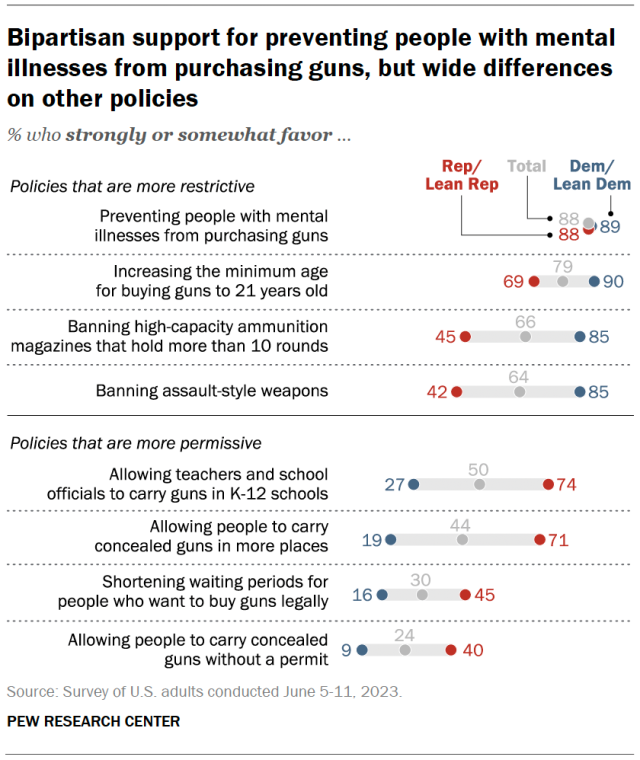
Republicans and Democrats differ on several other proposals. While 85% of Democrats favor banning both assault-style weapons and high-capacity ammunition magazines that hold more than 10 rounds, majorities of Republicans oppose these proposals (57% and 54%, respectively).
Most Republicans, on the other hand, support allowing teachers and school officials to carry guns in K-12 schools (74%) and allowing people to carry concealed guns in more places (71%). These proposals are supported by just 27% and 19% of Democrats, respectively.
Gun ownership is linked with views on gun policies. Americans who own guns are less likely than non-owners to favor restrictions on gun ownership, with a notable exception. Nearly identical majorities of gun owners (87%) and non-owners (89%) favor preventing mentally ill people from buying guns.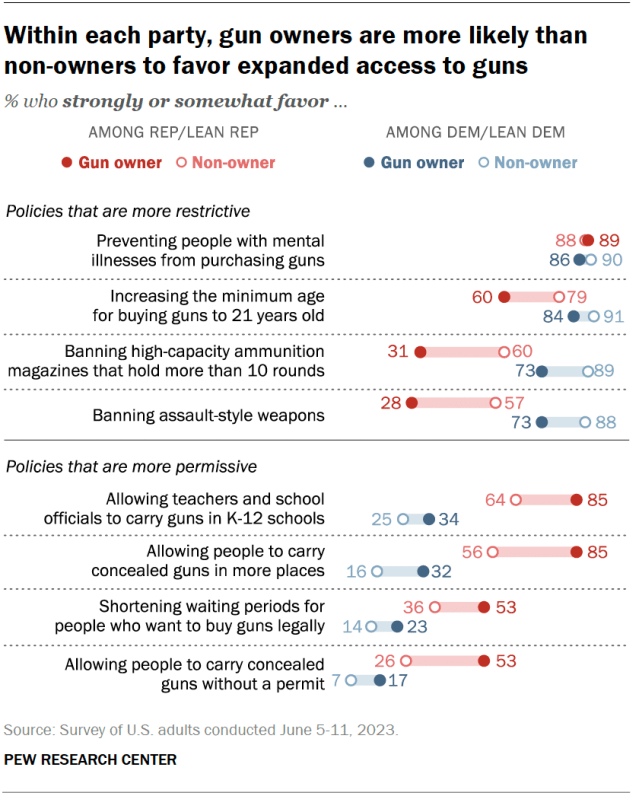
Within both parties, differences between gun owners and non-owners are evident – but they are especially stark among Republicans. For example, majorities of Republicans who do not own guns support banning high-capacity ammunition magazines and assault-style weapons, compared with about three-in-ten Republican gun owners.
Among Democrats, majorities of both gun owners and non-owners favor these two proposals, though support is greater among non-owners.
Note: This is an update of a post originally published on Jan. 5, 2016.
03
White House to announce first-ever federal office of gun violence prevention, AP sources say
WASHINGTON (AP) — President Joe Biden is creating the first-ever federal office of gun violence prevention, according to two people familiar with the plans.
The office will coordinate efforts across the federal government and will offer help and guidance to states struggling with increasing gun violence, while taking the lead on implementation of the bipartisan gun legislation signed into law last year. Biden tentatively plans to announce the new effort with an event Friday at the White House, said the people, who had direct knowledge of the plans and who spoke to The Associated Press on condition of anonymity because they were not authorized to speak publicly.
The office fulfills a key demand of gun safety activists who banded together as a coalition to endorse Biden for president in 2024, and is an effort by the White House to keep the issue front-and-center as the president pushes for a ban on so-called “assault weapons” and urges Congress to act.
“The creation of an Office of Gun Violence Prevention in the White House will mark a turning point in how our federal government responds to an epidemic that plagues every state and every community in America,” said Kris Brown, president of the gun safety group Brady, which has advocated for the office since 2020.
“Tackling this epidemic will take a whole-of-government approach, and this new office would ensure the executive branch is focused and coordinated on proven solutions that will save lives.”
Greg Jackson, the executive director of the Community Justice Action Fund, and Everytown for Gun Safety’s Rob Wilcox are expected to hold roles in the newly created office, which White House staff secretary Stef Feldman will oversee, the people said. The White House’s plans were first reported by The Washington Post.
“There are few people who care more about the work of gun violence prevention than President Biden,” said Sen. Chris Murphy, D-Conn., who has drafted legislation with Rep. Maxwell Frost, D-Fla., that would create such an office. “Establishing a White House office dedicated to this fight will save thousands of lives and strengthen the federal government’s implementation of the Bipartisan Safer Communities Act.”
Firearms are the No. 1 killer of children in the U.S., and so far this year 220 children younger than 11 have died by guns and 1,049 between the ages of 12 and 17 have died. As of 2020, the firearm mortality rate in the U.S. for those under age 19 is 5.6 per 100,000. The next comparable is Canada, with 0.08 deaths per 100,000.
But Republican support for gun restrictions is slipping a year after Congress passed the most comprehensive firearms control legislation in decades with bipartisan support, according to a recent poll from The Associated Press-NORC Center for Public Affairs Research.
Most Democrats, 92%, want gun laws made stronger, in line with their views in a UChicago Harris/AP-NORC poll conducted in July 2022. But Republican desire for more expansive legislation has dropped to 32% from 49% last summer and independents’ support has also declined slightly to 61% from 72%.
Yet despite the political divide, both sides believe it’s important to reduce mass shootings that plague the nation, the poll found. As of Monday, there have been at least 35 mass killings in the U.S. so far in 2023, leaving at least 171 people dead, not including shooters who died, according to a database maintained by the AP and USA Today in partnership with Northeastern University.
That puts the country on a faster pace for mass killings than in any other year since 2006, according to the database, which defines a mass killing as one in which four or more people are killed, not including the perpetrator, within a 24-hour period.
